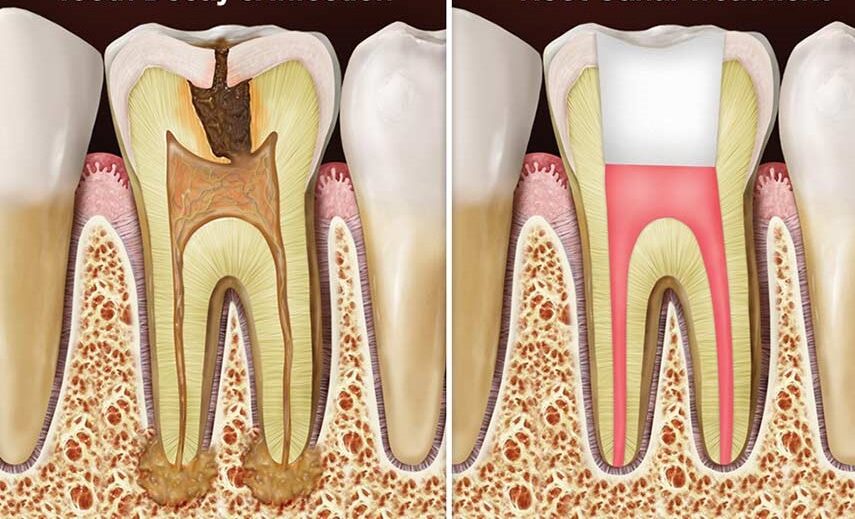Root Canals

Dental Root Removal Treatment in Vizag: Gentle, Modern & Effective Care at Smile Care Dental Hospital
Tooth pain can be excruciating—but thanks to Smile Care Dental Hospital, we can help you smile again. Our dental root removal treatment in Vizag uses the latest techniques and always with a gentle touch to protect and preserve your oral health.
Our clinic has been rated as one of the best dental clinics in Vizag, and families and working professionals recommend us for being up-to-date with modern dental practices. We make the difference between a standard root canal and a larger root removal a painless proposition and our skilled clinical team works as fast and as safe as possible.
What Is Dental Root Removal?
Dental root removal is a procedure that removes infected or decayed pulp tissue located in the tooth roots. If left untreated, they can lead to an abscess, bone loss, or complete tooth loss. This procedure may fit in a root canal type treatment or, in most severe examples, a surgical position where removal of the tooth root was required to help stop the disease process from spreading.
Smile Care returns to the roots of therapy when patients accept their care plan. Smile Care also devotes their efforts to procedures promoting conservative root removal, yielding a pleasant living experience even when the tooth is absent.
The dentistry model used in practice is dedicated to not only repairing and restoring function and comfort, but to not replace a natural tooth whenever possible using minimally invasive methods to restore function and comfort.
When Do You Need Root Canal or Root Removal Treatment?
Many patients visit us for dental root removal in Vizag with symptoms like:
- Continuous or sharp toothache
- Sensitivity to hot or cold foods
- Pain while chewing or biting
- Gum swelling or tenderness
- Discoloration or darkening of a tooth
- A pimple-like bump on the gum (possible abscess)
These symptoms typically signal infection or inflammation inside the tooth. Our advanced diagnostic tools, including digital X-rays and intraoral scanners, allow us to detect the issue precisely and act fast.
The Smile Care Approach to Dental Root Removal in Vizag
As one of the best dental clinic in Vizag, Smile Care stands apart with a holistic, technology-driven approach. Every patient receives:
- A Comprehensive Diagnosis: We start by thoroughly examining your tooth and surrounding tissues using high-precision imaging to determine the extent of infection and the appropriate treatment path—root canal therapy or surgical root removal.
- Painless, Local Anesthesia-Driven Procedures: Comfort is key. Our procedures are performed under local anesthesia to ensure a pain-free experience. Most of our patients report minimal discomfort, thanks to our use of modern rotary tools and apex locators for accuracy.
- Clean & Efficient Root Cleaning: The infected pulp is carefully removed, and the root canal is disinfected. We then seal it with a biocompatible filling material to prevent reinfection. In rare cases where the root structure is damaged beyond repair, we proceed with root removal or surgical extraction in the safest manner possible.
- Long-Term Restoration: To restore strength and aesthetics, a dental crown is often placed after treatment. We offer a variety of crown materials—ceramic, zirconia, and metal-ceramic—designed to blend seamlessly with your natural smile.
Why Vizag Chooses Smile Care for Root Canal & Root Removal Treatments
In a city filled with dental clinics, Smile Care has emerged as a preferred destination for dental root removal treatment in Vizag for a few important reasons:
- Experienced Specialists: Our team includes highly trained endodontists and oral surgeons who bring precision and care to every case.
- Cutting-Edge Facilities: From rotary endodontics to digital scanning and zero-contamination sterilization systems, we use only the most advanced tools.
- Ethical, Transparent Practices: We explain your condition, show you the diagnosis, and help you choose the most suitable treatment option.
- Patient Comfort First: Whether you’re 15 or 65, our staff ensures a friendly, calm environment where your well-being is our top priority.
- Affordable Care: High-quality treatment doesn’t have to come with high prices. We offer transparent pricing and value-driven treatment plans tailored to your needs.
Life After Root Canal or Root Removal
Our treatments are designed to help you bounce back quickly. Most patients resume normal activities within 24 hours, and with proper care, the treated tooth can last a lifetime. Post-treatment care is simple:
- Avoid chewing hard foods on the treated side for a few days
- Maintain excellent oral hygiene with brushing, flossing, and gentle rinsing
- Come for timely follow-up appointments if a crown placement or restoration is scheduled
A Trusted Name for Dental Excellence in Vizag
From the moment you walk into Smile Care Dental Hospital, our focus is on one thing: giving you relief from pain and restoring your oral health with the highest standards of care. With a proven track record of successful procedures, Smile Care continues to set the benchmark for dental root removal in Vizag.
Our reputation as one of the best dental clinics in Vizag comes not only from our clinical results but also from the relationships we build with our patients. We take time to understand your concerns, explain your options clearly, and ensure that you feel empowered to make the right choice for your oral health.
If you or a loved one are experiencing signs of dental infection or have been advised to undergo root canal or root removal, trust the experts at Smile Care. Rediscover the comfort of a pain-free smile—done right, the first time.
